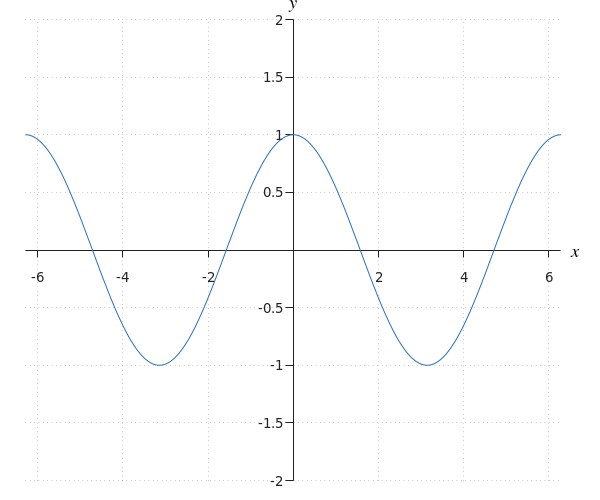Trigonometry: Trigonometric functions
 Trigonometric functions
Trigonometric functions
The sine, cosine, and tangent are not only used at angles, but can also be used as functions.
The sine function #f(x)=\sin(x)# is the function that adds the sine of #x# to each number #x#.
As we have seen in the unit circle, the function repeats every #2 \pi#. We therefore call the sine function a periodic function with #\blue{\text{period}}# #2 \pi#.
The function also has an #\green{\text{equilibrium}}#. This is the middle of the function, or the #y#-value that lies exactly between the highest and the lowest point. For the sine function, this is #0#.
Finally, the #\purple{\text{amplitude}}# of the function is equal to #1#. This means that the value between the equilibrium and the highest point (or the lowest point) equals #1#.
The cosine function #f(x)=\cos(x)# is the function that adds the cosine of #x# radians to each number #x#.
Like the sine function, the cosine function is a periodic function. This too has #\blue{\text{period}}# #2\pi#.
The #\green{\text{equilibrium}}# is equal to #0#.
Additionally, the #\purple{\text{amplitude}}# of the function is equal to #1#.
When we compare the cosine function with the sine function, we see that the graphs are very similar. When we move the cosine function to the right by #\frac{\pi}{2}#, we have the sine function.
The tangent function #f(x)=\tan(x)# is the function that adds the tangent of #x# radians to each number #x#.
Like the sine and cosine functions, the tangent function is a periodic function. The #\blue{\text{period}}# is equal to #\pi#.
The vertical asymptotes of the tangent function are #x=\frac{\pi}{2}+k \cdot \pi#, in which #k# is an integer, as for the #x#-values #\frac{\pi}{2}#, #\frac{3 \pi}{2}# and #\frac{5 \pi}{2}#, but also for #\frac{-3 \pi}{2}#.

To which function does this graph belong?
We see a function with its equilibrium equal to #0#, period #2 \pi# and amplitude #1#. Furthermore, the function passes through point #\rv{0,1}#. This means the function is equal to #f(x)=\cos \left(x\right)#.

Or visit omptest.org if jou are taking an OMPT exam.



